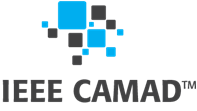CALL FOR PAPERS
The advent of 5G Networking introduces significant challenges in almost every link of the network value chain. The demand for seamless connectivity, extremely low latency, high-speed data transfer and energy efficiency along with the exponential increase of interconnected devices will shape an ecosystem with such complexity that enforces the replacement of almost every current standard.In addition, backwards compatibility remains an absolute necessity, despite the introduction of new architectural paradigms which facilitate a new breed of services primarily based on M2M communication schemes and cutting-edge sensing infrastructure integration.
5G Network design aims to mitigate problems and shortcomings of today’s networks, such as long service instantiation times, resource over-provisioning for meeting peak subscriber demand, dependence on obsolete and cost-ineffective hardware devices and extended manual configuration tactics which lack network awareness or operate based on self-organization principles. This intention leads to an increasing need for networking briskness and agility that can be attained via the virtualization of network processing functions, which will further enhance the proposed ecosystems’ability for self-configuration, self-organization and self-healing.
In this respect, this Special Session aims at providing a forum where researchers,engineers, and practitioners may discuss the latest advances on architectures, algorithms, abstractions, and technologies for briskness, flexibility, and agility in 5G networking and its various verticals.
Main Topics of Interest
We strongly encourage submission of innovative work on contemporary network design. The following is a non-exhaustive list of topics:
- 5G Network architectures, protocols, application programming interfaces, and programming languages
- Reliability, verification, resiliency, and fault management in 5G Networks
- Autonomic management technologies in 5G Networks
- Multi-access Edge Computing platform design, implementation and evaluation
- Fog Computing platform design, implementation and evaluation
- Security functions and services in contemporary network
- Leveraging 5G Networking paradigms for IoT platforms and IoT-based services
- 5G Networking applications in Smart Cities/Environments
- Application of machine learning,big data analytics in 5G Networks
- Scalable distributed and hierarchical controller architectures
- Software-based integration of computing, storage, and networking elements in 5G Networks
- PHY Layer enhancements for 5G Networking
- Self-configuration/optimization/healing techniques in contemporary networking
- Optimal network configuration principles in contemporary networking
- Environmentally-aware techniques for Green Networking
- New forwarding abstractions and programmability paradigms in 5G Networks
- Architectures for Cloud-native micro-services in 5G Networks
- Use and performance of container techniques
- Data and control plane conformance, interoperability, scalability, and performance studies
- Design guidelines for scalable, highly-available and modular elements for 5G Networks
- Dynamic service function chaining
- OpenStack/Open vSwitch(OVS)/OPNFV/ONOS-related research & explorations
- Service chaining/orchestration and traffic steering in NFV andSDN
- Tools for validating network services and automated deployment and management
- Applying compositional patterns for parallelism, control logic, performance, and reliability of network services
- Network Codding in contemporary networks
- Design of NFV and SDN-based forwarding elements
- Performance evaluation, optimization, isolation, tradeoffs with NFV workloads
- Control plane architectures and network operating systems in NFV and SDN
- NFV infrastructure architectures including hardware acceleration technologies
- NFV & SDN on public/private clouds
- Commercial models and implications for NFV and SDN ecosystems
SPECIAL SESSION CHAIRS
- Ilias Politis, PhD–Senior Researcher, University of Patras
- Christos Tselios –Senior Researcher, Citrix Systems Inc.
SUBMISSION
Manuscripts must be prepared in the standard IEEE two-column conference format with a maximum paper length of six (6) printed pages (maximum 1 additional page with over length page charge) and submitted via the provided EDAS link.


